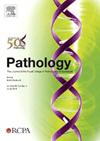Evaluation of a customised Sensititre YeastOne plate containing isavuconazole for antifungal susceptibility testing in Singapore
IF 3
3区 医学
Q1 PATHOLOGY
引用次数: 0
Abstract
This study evaluated the performance of a customised Sensititre YeastOne (SYO) plate including isavuconazole (YIT) against existing practice (comprising SYO YO10 plate and isavuconazole gradient strip) in order to streamline the workflow for antifungal susceptibility testing in a tertiary hospital in Singapore. A total of 101 (51 yeasts and 50 moulds) clinical isolates were included for analysis. Isolates included in the study were recovered from a variety of body sites and reflected the case mix encountered in daily practice. Antifungal susceptibility testing was performed using three methods: YO10, YIT and gradient diffusion strip (for isavuconazole only). Reproducibility, essential agreement (EA) and categorical agreement (CA) were calculated. When YO10 and YIT plates were compared, the reproducibility was 100% for eight common antifungals. The CA was >97% for all antifungals except for amphotericin B (89.4%), but this was attributed to seven isolates with minimum inhibitory concentrations bordering the wild-type (WT) cut-off. The EA obtained when testing isavuconazole using YIT versus gradient diffusion was 77.2% overall, 90.2% for yeasts and 64% for moulds. In conclusion, the YIT plate is suitable for antifungal susceptibility testing of yeasts in our laboratory. Its use for mould isolates needs to be monitored further.
在新加坡对含有异黄酮唑的定制 Sensititre YeastOne 平板进行抗真菌药敏试验的评估。
本研究评估了定制的Sensititre YeastOne(SYO)平板(含异唑康唑,YIT)与现有方法(包括SYO YO10平板和异唑康唑梯度条)的性能对比,以简化新加坡一家三级医院的抗真菌药敏试验工作流程。共有 101 株(51 株酵母菌和 50 株霉菌)临床分离物被纳入分析。研究中的分离物来自不同的身体部位,反映了日常工作中遇到的病例组合。抗真菌药敏试验采用三种方法进行:YO10、YIT 和梯度扩散条(仅适用于异唑康唑)。计算了重现性、基本一致(EA)和分类一致(CA)。对 YO10 和 YIT 平板进行比较时,8 种常见抗真菌药的重现性为 100%。除两性霉素 B(89.4%)外,所有抗真菌药物的 CA 均大于 97%,但这是因为有 7 个分离物的最低抑制浓度接近野生型(WT)临界值。使用 YIT 与梯度扩散法检测异黄酮唑时所获得的 EA 值总体为 77.2%,对酵母菌的 EA 值为 90.2%,对霉菌的 EA 值为 64%。总之,YIT 平板适用于我们实验室的酵母菌抗真菌药敏试验。对霉菌分离物的使用还需进一步监测。
本文章由计算机程序翻译,如有差异,请以英文原文为准。
求助全文
约1分钟内获得全文
求助全文
来源期刊

Pathology
医学-病理学
CiteScore
6.50
自引率
2.20%
发文量
459
审稿时长
54 days
期刊介绍:
Published by Elsevier from 2016
Pathology is the official journal of the Royal College of Pathologists of Australasia (RCPA). It is committed to publishing peer-reviewed, original articles related to the science of pathology in its broadest sense, including anatomical pathology, chemical pathology and biochemistry, cytopathology, experimental pathology, forensic pathology and morbid anatomy, genetics, haematology, immunology and immunopathology, microbiology and molecular pathology.
 求助内容:
求助内容: 应助结果提醒方式:
应助结果提醒方式:


